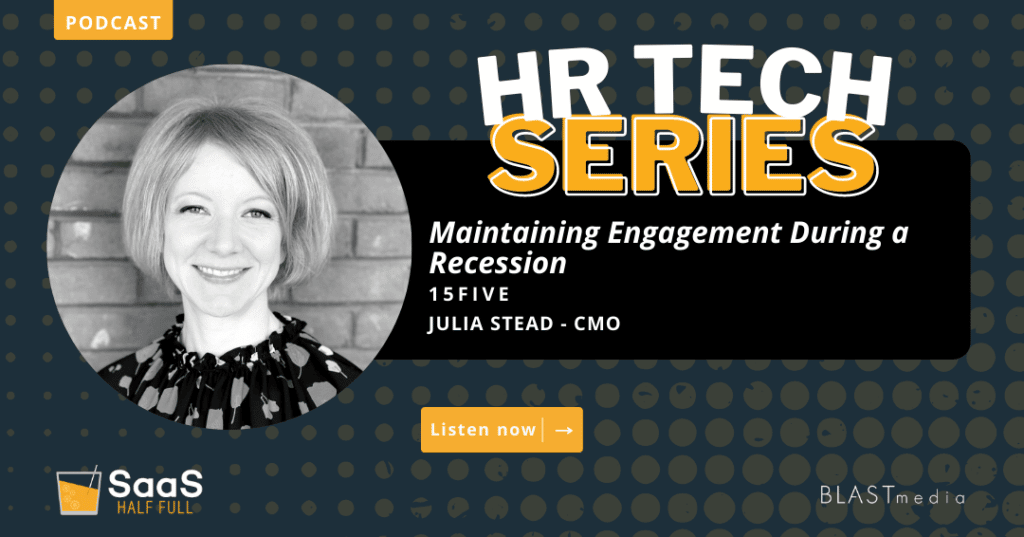
Maintaining employee engagement is daunting during an economic downturn when trying to balance high care and high performance. With the complexities this topic can bring, Lindsey Groepper speaks with Julia Stead, CMO at 15Five, to discuss how quickly trends in employee engagement have changed when transitioning from the Great Resignation into (what some are calling) the “Great SaaSacre.” This third conversation in the HR tech series also details the shift in power dynamic from employee to employer, the value of transparency and the positive trends they’re seeing due to the recession. As businesses navigate these changes, it becomes imperative for leaders to learn how to improve engagement effectively. Embracing transparency and recognizing the changing power dynamics offer organizations a strategic advantage in navigating the challenges of the current economic climate. As we glean insights from the conversation with Julia Stead, it becomes evident that learning how to improve engagement is not just a proactive measure but a fundamental necessity for fostering resilience and success amid the fluctuations of the “Great SaaSacre.”
Lessons from the Great Resignation
From her vantage point at the intersection of marketing and HR, Julia had one word for the seismic power shifts across industries during the Great Resignation: “nuts.” Workers were frustrated with a lack of career growth and stalled compensation. Businesses struggled to use old tactics to recruit and retain talent in a transformed environment. The result? The war for talent dominated headlines for months. As the market — and the employee-employer power dynamic — shifts, Julia identified two main positives emerging from this period.
First, companies examined their holistic compensation strategy to understand and improve the value they offered employees. Second, people who changed jobs reflected on what they sought in an employer.
“[This shift gave] everyone a little bit more pause to reflect on what’s important to them and making smart choices in the kinds of careers or jobs they were pursuing to better align with what they want to be doing, which I think ultimately then leads to higher overall engagement and satisfaction,” Julia said.
While the Great Resignation brought some welcome changes, according to Julia, the frenzy to hire led many businesses to lower the bar for performance, both internally and throughout hiring processes. Some companies needed a “warm body” to get through the quarter, while others attempted to meet the new demands of incoming employees. As budgets tighten, companies must navigate a tricky path to highlight performance goals while bracing for changes like hiring freezes and, sometimes, layoffs.
Navigating a reduction in force
Compared with past recessions, Julia has noticed more empathy from leaders as businesses, especially in B2B SaaS, go through layoffs. From LinkedIn posts to internal communications, companies are bringing kindness and transparency to difficult situations. And business leaders are sharing more often about the company’s health and outlook.
“People are scared when they don’t know what’s going on, or they don’t know what’s going to happen,” Julia said. “And when you don’t have access to information, you make up stories in your head, what you think is going to happen. And usually those stories are worst-case scenarios.”
Being as honest as you can about how your business is weathering economic upheaval not only gives teams a shared understanding of overall business health — it also refocuses their attention on the work that will offer the most significant impact.
Balancing high care with high performance
How do leaders help those who “made the cut” after layoffs? Balance high care with high performance to keep teams energized. The role of management is two jobs, in Julia’s view. You’re managing the craft — in her case, B2B SaaS marketing. But the other half is being a good people leader; you can’t neglect that role.
“Once I made the mindset shift of like, ‘Hey, 50% of my job has nothing to do with marketing. It has to do with people management, getting to know them, building relationships, having hard conversations, having exciting, positive conversations,’ — Just acknowledging that for myself went a long way because it made me prioritize the right amount of my time to both pursuits,” Julia said.
Rather than trying to heal wounds with social activities, Julia recommended two strategies: letting your teams feel their feelings and rallying them around a compelling work project to unite them in pursuit of a shared goal.
To hear more of Julia’s insights, listen to Episode 333 of SaaS Half Full.




